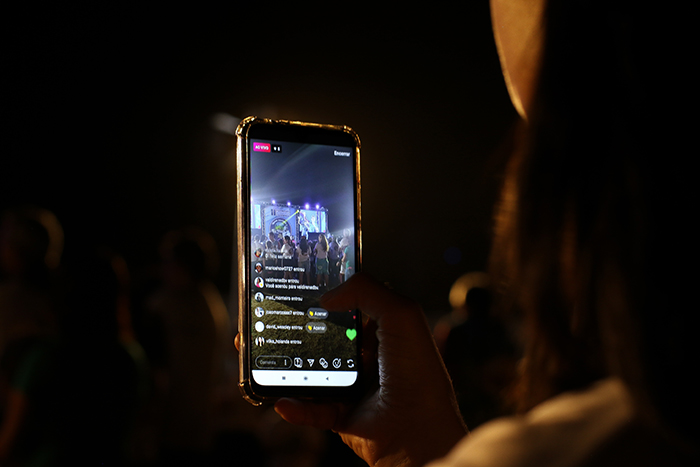Researchers analyze law of livestreaming, how it can adjust as technology evolves

LAWRENCE — As the COVID-19 pandemic has shuttered large sections of society, people have turned to livestreaming for everything from performing music to education and court hearings. But streaming has been around for years, as have persistent questions about the ethics of questionable and violent content put online and how the law handles such situations. In this context, two scholars have published an essay analyzing the law of livestreaming and how it could be adjusted as the nature of internet streaming evolves.

Genelle Belmas, associate professor of journalism & mass communications at the University of Kansas, and Brian Larson, associate professor of law at Texas A&M University, co-wrote “Fixed? The Law of Live-Streaming,” part of the book “Legal and Ethical Issues of Livestreaming,” Lexington Books, published last month. The chapter reviews the law that covers liability and protections for livestreaming, including Section 230 of the Communications Decency Act, which provides near blanket protections for social media and internet platforms.
The authors said that livestreaming through means such as Facebook Live is legally very similar to uploading content that is streamed later through means such as YouTube. In cases of livestreaming, content appears to be broadcast on the internet as something is happening, but technology of various platforms ensures recordings are being made during the whole process, triggering the traditional legal mechanisms. There are a few areas in which livestreaming has been singled out, such as public meetings held via Zoom, and courts are currently trying to address legal questions regarding that content.
Under Section 230, platforms such as YouTube, Twitter, Facebook and Twitch are almost never held liable for content streamed through their services. That includes objectionable content such as violence, suicide and sexual imagery.
“The immediacy means in situations where you’re a gunman or you’re going to commit suicide, the only way you could share that is through livestreaming,” Larson said. “That makes it ethically fraught. On the legal front, though, Section 230 provides pretty darn good — though not absolute — protection for internet providers.”
Online service providers have been found not liable for distributing numerous instances of livestreamed violence and suicide, principally because they do not exercise editorial control over the content. That differs from print publishers, the authors point out; in print if someone received untrue or damaging content and still published it, they would likely be liable for publishing it with knowledge of its content.
Larson and Belmas examine Section 230, famously referred to as “The 26 words that founded the internet.” Those words — “no provider or user of an interactive computer service shall be treated as the publisher or speaker of any information provided by another information content provider” — essentially made possible the internet as a place where people can share interactive content. The authors point out it may have made sense to have such broad legal protection for websites when the Communications Decency Act was passed in 1996, but the rapid evolution of technology since suggests changes may be needed.
“Absolutely there is room for a thoughtful discussion on how to fix this. It is hard to defend such heinous behavior by some streaming violence, sexual exploitation or other terrible stuff, but how do you also allow free speech?” Belmas said. “In theory, at least, we could find a way to curb some of the most egregious examples.”
Belmas and Larson cite steps that have been taken to fight web exploitation, including the Fight Online Sex Trafficking Act of 2017, commonly known as FOSTA. Even such attempts that seem noble on the surface have met with resistance as sex worker advocates say it has inadvertently removed protections they had when conducting their work online.
Larson and Belmas said they hope their chapter provides basic knowledge of how things stand currently so scholars and policymakers can consider remedies for the legal and ethical problems that surround livestreaming. While written largely before the COVID-19 pandemic, the authors point out that the pandemic will certainly raise new questions in streaming without rendering existing law moot. “Just because we have COVID-19 doesn’t mean all these laws we’ve had for a long time aren’t there anymore,” Larson said.
Belmas points out that in the COVID-19 era, government institutions are holding public meetings online via means such as Zoom and are having to find ways to allow public comment, make meetings and records accessible and post notice of meetings. Courts are holding session remotely, and even institutions as storied as the Supreme Court have made changes to allow streaming of their proceedings – at least the audio, as the high court uses phone arguments rather than video-enabled technologies – and recordings of oral arguments are posted weekly on the Court’s website. That move can have a democratizing effect but could also make less government function publicly open, depending on how entities handle it.
“In one sense,” Larson said, “streaming court proceedings is very democratizing: Courtrooms are designed to emphasize the distance and authority of the judge. But in Zoom, we all look like idiots: A judge’s kid or cat can walk into the shot just like yours or mine can.”
Image credit: Pexels.com